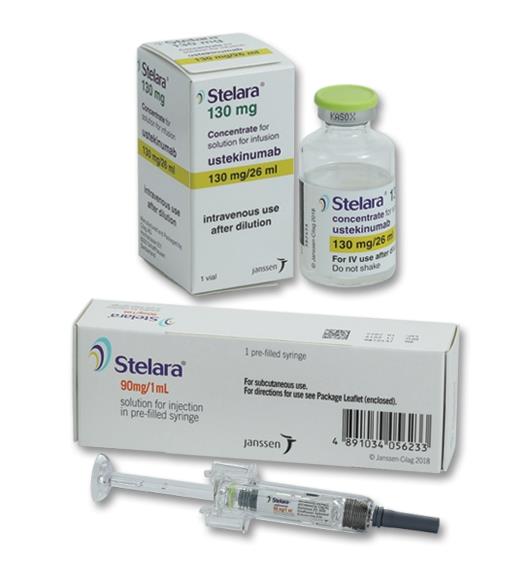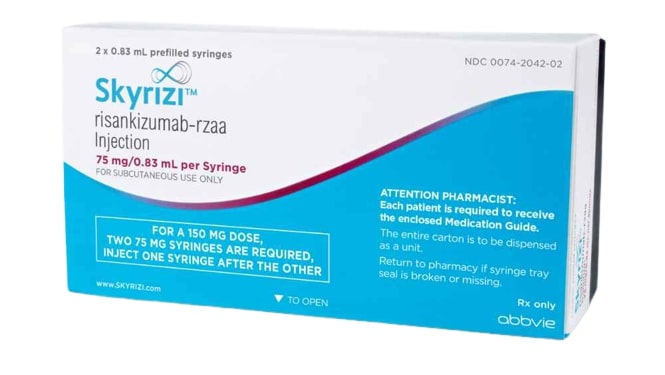Stelara (ustekinumab) vs Skyrizi (risankizumab)
Stelara (ustekinumab) vs Skyrizi (risankizumab)
Stelara (ustekinumab) and Skyrizi (risankizumab) are both biologic medications used to treat moderate to severe plaque psoriasis and other inflammatory conditions, but they target different proteins involved in the inflammatory process. Stelara blocks interleukins IL-12 and IL-23, which are believed to play a key role in inflammatory and immune responses, while Skyrizi specifically inhibits IL-23 alone, which may offer a more targeted approach to treatment. The choice between Stelara and Skyrizi should be made in consultation with a healthcare provider, considering factors such as individual patient response, medical history, potential side effects, and the frequency of dosing, as Stelara is typically administered every 12 weeks after initial doses, and Skyrizi every 12 weeks after two initial doses given four weeks apart.
Difference between Stelara and Skyrizi
| Metric | Stelara (ustekinumab) | Skyrizi (risankizumab) |
|---|---|---|
| Generic name | Ustekinumab | Risankizumab |
| Indications | Plaque psoriasis, psoriatic arthritis, Crohn's disease, ulcerative colitis | Plaque psoriasis, psoriatic arthritis |
| Mechanism of action | Interleukin-12 and interleukin-23 antagonist | Interleukin-23 antagonist |
| Brand names | Stelara | Skyrizi |
| Administrative route | Subcutaneous, intravenous | Subcutaneous |
| Side effects | Upper respiratory infections, headache, fatigue, injection site reactions | Upper respiratory infections, headache, fatigue, injection site reactions, fungal skin infections |
| Contraindications | Active tuberculosis, severe infections, hypersensitivity to ustekinumab | Active tuberculosis, severe infections, hypersensitivity to risankizumab |
| Drug class | Monoclonal antibody | Monoclonal antibody |
| Manufacturer | Janssen Biotech | AbbVie |
Efficacy
Efficacy of Stelara (Ustekinumab) in Treating Psoriasis
Stelara (ustekinumab) is a biologic medication approved by the U.S. Food and Drug Administration (FDA) for the treatment of moderate to severe plaque psoriasis in adults who are candidates for phototherapy or systemic therapy. Stelara works by targeting interleukin-12 (IL-12) and interleukin-23 (IL-23), two proteins that can play a role in the inflammation associated with psoriasis. Clinical trials have demonstrated that Stelara can lead to significant skin clearance in many patients. For instance, in two pivotal Phase III trials, more than two-thirds of patients achieved at least a 75% reduction in the Psoriasis Area and Severity Index (PASI 75) after 12 weeks of treatment, with continued improvement observed with ongoing therapy.
Long-term studies have also supported the sustained efficacy of Stelara for psoriasis treatment. In these studies, patients maintained substantial skin clearance over several years with continuous use. The safety profile of Stelara has been well-characterized, with most adverse events being mild to moderate in severity and generally not leading to discontinuation of therapy. The convenience of Stelara's dosing schedule, which typically involves an initial dose followed by a dose at week 4 and then every 12 weeks thereafter, may also contribute to patient adherence and satisfaction.
Efficacy of Skyrizi (Risankizumab) in Treating Psoriasis
Skyrizi (risankizumab) is another biologic medication approved by the FDA for the treatment of moderate to severe plaque psoriasis in adults who are candidates for systemic therapy or phototherapy. Skyrizi specifically targets interleukin-23 (IL-23) and has been shown to provide significant skin clearance for patients with psoriasis. In pivotal Phase III trials, Skyrizi demonstrated high levels of efficacy, with up to 90% of patients achieving PASI 90, which represents a 90% reduction in the PASI score, by week 16 of treatment. Additionally, over 50% of patients achieved PASI 100, indicating complete skin clearance.
The long-term efficacy of Skyrizi has been evaluated in extension trials, where the high rates of skin clearance were maintained for up to two years in the majority of patients. The medication is administered as an under-the-skin injection at week 0 and 4, and then every 12 weeks, which may be convenient for patients. The safety profile of Skyrizi is similar to other biologics, with most side effects being mild to moderate. The robust clinical trial data and the long-term efficacy results have made Skyrizi a valuable addition to the therapeutic options available for patients with psoriasis.
Regulatory Agency Approvals
Stelara
-
European Medical Agency (EMA), European Union

-
Food and Drug Administration (FDA), USA

Skyrizi
-
European Medical Agency (EMA), European Union

-
Food and Drug Administration (FDA), USA

-
Therapeutic Goods Administration (TGA), Australia

Access Stelara or Skyrizi today
If Stelara or Skyrizi are not approved or available in your country (e.g. due to supply issues), you can access them via Everyone.org.
How it works

Make an enquiry
Choose the medicine you want to buy, answer a couple of questions, and upload your prescription to speed things up. We’ll get back to you within 24 hours.


Make an enquiry
Choose the medicine you want to buy, answer a couple of questions, and upload your prescription to speed things up. We’ll get back to you within 24 hours.


Breeze through the paperwork
We'll guide you through the required documents for importing unapproved medicine, ensuring you have all the necessary information.


Get a personalized quote
We’ll prepare a quote for you, including medicine costs and any shipping, administrative, or import fees that may apply.


Receive your medicine
Accept the quote and we’ll handle the rest - sourcing and safely delivering your medicine.

Some text on this page has been automatically generated. Speak to your physician before you start a new treatment or medication.
Let's talk
If you have any questions, call us or send us a message through WhatsApp or email:
Contact us




